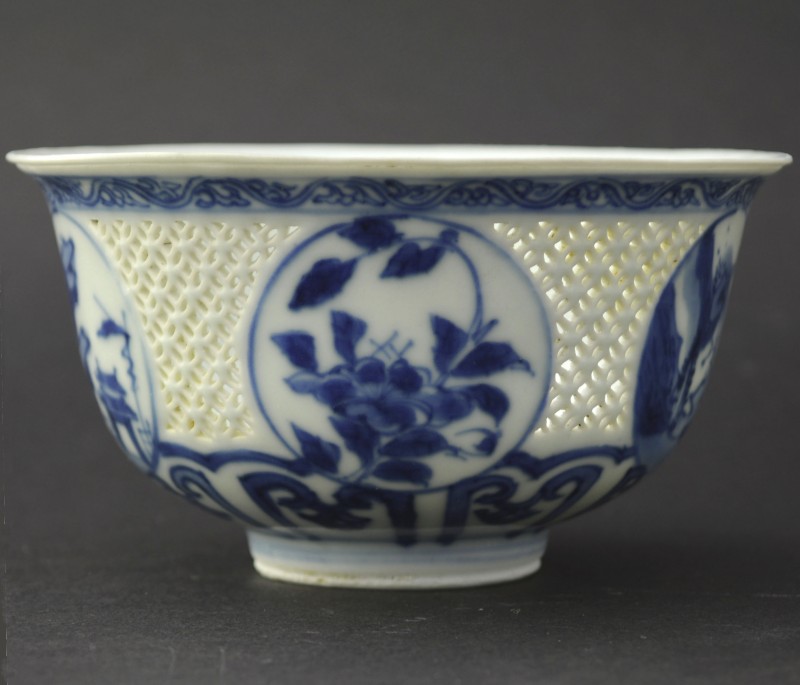
A Blue and White Transitional porcelain Linglong bowl. From the Hatcher Cargo, Chongzhen period (1628-1644). Diameter: 9 cm. The sides are cut through to leave circular panels decorated with various landscape or flower motifs. A very similar Transitional Porcelain bowl is illustrated in : Chinese Ceramics of the Transitional Period 1620-1683 (China Institute in America, Stephen Little, 1983) page 72, plate 24.
In Chinese porcelain, walls pierced with openings so as to form a network. This open work when performed on Chinese porcelain was called ling long, 'devil's work' or 'delicate openwork'. If the openwork is filled with glaze, it is usually called 'rice grain'.
Pére Francois Xavier d'Entrecolles (1664-1741) used the term 'reticulated' in the 18th century to describe porcelain that had the appearance of a net.
The clay would have been cut by hand when it was 'leather hard'. Great skill was required both in cutting the designs and firing the clay.
There is an example in the collection of the Rijksmuseum, Amsterdam, illustrated in Christiaan J.A. Jörg, Chinese Ceramics in the Collection of the Rijksmuseum, Amsterdam: The Ming and Qing Dynasties, London, 1997, p. 82, no. 71. Here Jörg notes that this style of bowls is mentioned in VOC (Dutch East India Company) records of 1643-1646.
The design type goes back into the Ming dynasty where it in my view seems to have been imported from the Middle East. Chinese scholarship traces pierced wares back to the Sui and Tang dynasties.
The most common pieces of this type on the market is from a large lot of small reticulated bowls that came from the Hatcher Ming cargo that were all of one type and can be recognized by its slightly dulled glaze that is said to have been caused by the Hatcher staff clearing off corals with battery acid. This, I have no source for other than trade gossip but is worth taking note of since the dullness is an observable fact that helps identify this particular cargo. In the trade this surface is explained as that the glaze is slightly degraded due to immersion in salt water.
For more information: Margaret Medley, Illustrated Catalog of Underglaze Blue and Copper Red Decorated Porcelains in the Percival David Foundation of Chinese Art, London, 1976, plate XI, nos. B620 and B623, listed p. 57, and Chen Runmin, Selected Chinese Ceramics from the Palace Museum (Volume 1): Blue and White Ceramics in Shunzhi and Kangxi Periods (Qing Shunzhi Kangxi chao qing hua ci), Beijing, 2005, p. 203, no. 124.
See also: Ling Long openwork or
See also: Rice grain porcelain
A